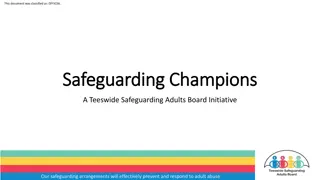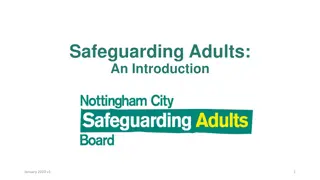Three-Phase Approach to Safeguarding for Leaders
Designated leaders must adopt a three-phase approach to safeguarding: proactive culture-building, reactive incident management, and reflective understanding for improvement. This program aims to enhance leadership skills in safeguarding, cultivate a robust safeguarding culture, and manage incidents effectively. Key areas of focus include training, supervision, staff awareness, and creating a safe environment for children and young people.
Uploaded on Oct 03, 2024 | 0 Views
Download Presentation

Please find below an Image/Link to download the presentation.
The content on the website is provided AS IS for your information and personal use only. It may not be sold, licensed, or shared on other websites without obtaining consent from the author. Download presentation by click this link. If you encounter any issues during the download, it is possible that the publisher has removed the file from their server.
E N D
Presentation Transcript
Safeguarding for Leaders / Designated Three phase approach: Proactive the culture - Reactive- the incident - Reflective-understanding how we got here and where next - Leads
Aims for the programme taking the strategic view. To be able to confidently identify the skills and knowledge required as a leader with responsibility for safeguarding. To understand the structure and impact that a robust safeguarding CULTURE brings. To be able to take a strategic view within the service/ organisation re. safeguarding in all aspects To confidently manage a full incident analysis, using theoretical approaches. To roll out a clear SMART improvement plan for change as a result To monitor , embed and review the impact of change To integrate a strategic view of Covid 19 into your work To maintain your own up to date , reflective safeguarding practice.
Safeguarding should sit within a contextual culture and it is your role to see that this is in place. What is this? Recruitment processes/safer recruitment processes. As the Manager or RI have you received this training? Training. Is staff training up to date and current? How are you sure of this? Supervision /Appraisal- up to date , reflective . Current , fits with the development plan for the Home / organisation. (supervision issues remains a key theme in Ofsted findings) Day to day information to staff- handovers in place? Sufficiently detailed? Appropriate? Enough time given?
Safeguarding culture continued. Breadth of experience within the team? Boundaries around relationships defining what love looks like for your Home. Rapid staff changeover why? If this is happening get it into your monitoring with a rationale and action plan. Policies , procedures , processes- staff awareness Record keeping staff awareness and competence. ANY document could end up in the legal arena Static staff team good for continuity but what problems could arise? Healthy challenge- do staff feel safe enough to do this? Do staff work within an Arena of Safety - take a couple of minutes to think about what this means.
Safeguarding culture- children and young people .. Placement-assessment, matching , transition , role of the Registered Manager in placing, meeting , transition , preparation for arrival, arrival in the Home- are all these process secure and underpinned by safeguarding at ALL times? Is the environment right- house , their room, outside space , location? What is homely? Is your Home /service like this? AND COVID we will have a separate session on this
Safeguarding culture and social pedagogy Social Pedagogy is an academic discipline that draws on core theories from various related disciplines, such as Education, Sociology, Psychology and Philosophy. In essence, it is concerned with well- being, learning and growth. The term 'pedagogy' originates from the Greek pays (child) and g (to lead, to guide). The social pedagogue i.e.. you , your team- works with the whole child, and supports their all-round development. Children s rights and participation underpin social pedagogy. The right to be safe is KEY. We talk of holistic ,integrated care as the best model to keep children safe and let them grow and develop- is this the culture in your Home /service? Can you prove that?
Safeguarding culturethe dreaded data? Can you use it and prove what you do? Data can play a part within your reviews of the quality of care / safeguarding provided as well as shape reviews of risk , location, activities etc. Physical Intervention- what is a PI? Training for staff- up to date and current practice? Why? When? Patterns ? Triggers? NB. Children reported that staff need to be able to avoid problems building up to a danger level and should only use restraint as a last resort. They accepted that restraint is sometimes necessary but only when someone is likely to get hurt or property is likely to get seriously damaged. They were clear that restraint should never involve pain and stressed the importance of staff training in how to restrain without hurting (Morgan, 2005,Longford 2018) Missing incidents- numbers , impact , outcomes, risks. Incidents- what is an incident? What do you class as an incident? Do you categorise them, check for peaks and troughs, explain why they have occurred , feed that in to potential patterns and issues , feedback to staff ,amend plans, amend risk assessments all as a result!!
Safeguarding culture..data continued. Regulation 40 notifications Data can give evidence in a quantitative format of issues which may arise and how you have monitored , tracked , recognised , assessed, planned and put actions in place. It should be balanced by your narrative (qualitative) understanding of what the safeguarding culture is in your home. Accidents First Aid Complaints or lower level grumps and grumbles Health and safety issues or RIDDOR notifications Staff turnover Can staff articulate what that culture is ? If not why not? Research shows that staff can quote policy and process and often little else.
What should a secure safeguarding culture mean for individual children and young people? Their individual needs are assessed , recognised and met They feel SAFE- each young person will define that word differently? Have you ever asked them what they need to feel safe? There is support for them to develop resilience- social, emotional , mental , physical. They can demonstrate progress at their own pace and level . There is the opportunity to develop an improved level of self esteem They are listened to and know this. There is involvement of all professionals and support which can help and support(social pedagogy model) They learn to settle, they choose to leave possessions out, they choose to move more freely around the house, they develop a greater sense of belonging and ownership
Feedback from children? Are we asking the right questions ? Are we listening? Areas that children and young people reflect on: Coming into care and what that feels like Wanting to feel safe Honesty about families and siblings Honesty about placement changes Don t give me a survey Don t just ask me what I want- listen to me ? Being made to feel different. Stigma education , home . Being surrounded by care language and processes Needing people to be honest about their past and help them fill in the gaps Ask me what I want to talk about- don t assume
Quotes- pauses for thought.. we just want to be treated like normal kids do we do this? Do we ask them? telling someone you are being removed is like telling someone you have cancer in care children should be given the best education and the best environment I d want to know if my parents want to try and change for us kids and they are getting support they need and trying to support themselves and get us back. I don t want to know if they didn t want to try because that d be heartbreaking be there, be consistent and available
- pause for thought. How would you describe the culture of hearing children in your service? Have you tested it yourself? Do your findings align with what the children and team say, as well as records, observation, conversation? Do you need to make any changes, speak with the team / RI about change? Most importantly do you need to speak with the young people about their views and ideas? Are they core to this process?
Anything else you can think of work in small groups of 3- 4 to think of any other areas. Safeguarding culture .. Nominate one person to note and one to present your feedback.
The role can be discreet to your own Home / service Leading into the next session the role of the leader/ DSL where does it fit? It can be a role which is designated for a group of services It can be an organisational role. It should be specified within a job description The boundaries of the role should be clear Its autonomy/ or not(?) should be clarified within an organisation- if it covers a group of services. The internal reporting mechanisms and management should be clear
What next? Review the dynamics and constituent parts of the safeguarding culture at your home or service. Are there any gaps or areas to develop? This is the start of your safeguarding review ... Next session- we will develop the theme of culture and look at risk and the impact of areas such as unconscious bias on how risk can be viewed.























